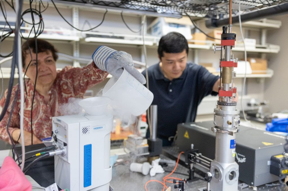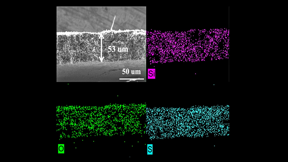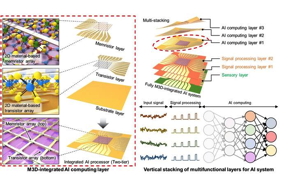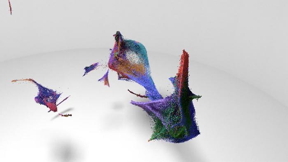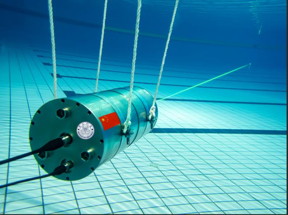Home > Press > Efficient heat dissipation perovskite lasers using a high-thermal-conductivity diamond substrate
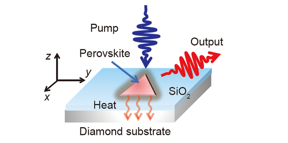 |
| The figure shows the schematic of the proposed optically pumped MAPbI3 whispering gallery mode (WGM) laser comprising a triangular MAPbI3 nanoplatelet, a SiO2 gap layer, and a diamond substrate. CREDIT ©Science China Press |
Abstract:
Perovskite lasers have rapidly achieved progress in developing continuous-wave excited lasing from a femtosecond pulse excited lasing, which is considered a critical step towards electrically excited lasing. After continuous-wave lasing at room temperature, the next goal is to realize electrically driven lasing. In commercially available electric injection lasers, traditional epitaxial grown single crystal semiconductors with both large thermal conductivity κ and high charge carrier mobility m usually exhibit small resistive heating under large current flow. While perovskites possess large and balanced charge carrier mobilities, they suffer from small κ values. The thermal conductivity of MAPbI3 is 1-3 W m−1 K−1, which is inferior to that of GaAs (50 W m−1 K−1). Hence, heat converted from energy loss through nonradiative pathways cannot be effectively dissipated. This failure will increase the lasing threshold as carriers occupy a broader energy range at a higher temperature, diluting the population inversion of any given transition along with other problems such as degradation and heat-induced defects. The lowest electric excitation threshold of a distributed-feedback (DFB) perovskite laser would be as high as 24 mA cm−2. Moreover, owing to high current injection in conventional perovskite light-emitting diode architectures used for laser devices, the external quantum efficiency would be significantly restricted under high current injection conditions owing to Joule heating. Hence, heat management is a bottleneck for developing perovskite-based electrically driven lasers.
Efficient heat dissipation perovskite lasers using a high-thermal-conductivity diamond substrate
Beijing, China | Posted on April 14th, 2023In this light, a group of researchers, including Prof. Guohui Li, Prof. Shengwang Yu, Prof. Yanxia Cui of Taiyuan University of Technology, and Prof. Kaibo Zheng of Lund University, demonstrated a perovskite nanoplatelet laser on a diamond substrate that can efficiently dissipate heat generated during optical pumping. The demonstrated laser features a Q factor of ~1962, a lasing threshold of 52.19 μJ cm−2. Tight optical confinement is also realized by introducing a thin SiO2 gap layer between nanoplatelets and the diamond substrate. Electric field distributions inside the structures shows that a wide SiO2 gap of 200 nm in thickness produces evidently less leakage field in the diamond substrate, simultaneously proposing better mode confinement within the MAPbI3 nanoplatelet. They evaluated the heat dissipation in perovskite nanoplatelet lasers on the diamond substrate by temperature variations under optical pumping conditions. The laser features a low pump-density-dependent temperature sensitivity (~0.56 ± 0.01 K cm2 μJ−1) through the incorporation of the diamond substrate. The sensitivity is one to two orders of magnitude lower than the values for previously reported perovskite nanowire lasers on glass substrates. The high-thermal-conductivity diamond substrate enables the nanoplatelet laser to operate at a high pump density. The study could inspire the development of electrically driven perovskite lasers. This work was published in SCIENCE CHINA Materials (https://doi.org/10.1007/s40843-022-2355-6)
This work was supported by the National Natural Science Foundation of China (U21A20496, 61922060, 61775156, 61805172,12104334, 62174117, and 61905173), the Key Research and Development Program of Shanxi Province (202102150101007), Shanxi-Zheda Institute of Advanced Materials and Chemical Engineering Program (2022SX-TD020), the Natural Science Foundation of Shanxi Province (20210302123154 and 20210302123169), the Research Project Supported by Shanxi Scholarship Council of China (2021-033), the Research Project Supported by Shanxi-Zheda Institute of Advanced Materials and Chemical Engineering (2021SX-FR008), and the Introduction of Talents Special Project of Lvliang City (Rc2020206 and Rc2020207). Guohui Li also acknowledges the support from China Scholarship Council (202006935009).
####
For more information, please click here
Contacts:
Media Contact
Bei Yan
Science China Press
Expert Contact
Guohui Li
Taiyuan University of Technology
Copyright © Science China Press
If you have a comment, please Contact us.Issuers of news releases, not 7th Wave, Inc. or Nanotechnology Now, are solely responsible for the accuracy of the content.
| Related Links |
| Related News Press |
News and information
![]() New family of wheel-like metallic clusters exhibit unique properties April 14th, 2023
New family of wheel-like metallic clusters exhibit unique properties April 14th, 2023
![]() Nanobiotechnology: How Nanomaterials Can Solve Biological and Medical Problems April 14th, 2023
Nanobiotechnology: How Nanomaterials Can Solve Biological and Medical Problems April 14th, 2023
![]() New Developments in Biosensor Technology: From Nanomaterials to Cancer Detection April 14th, 2023
New Developments in Biosensor Technology: From Nanomaterials to Cancer Detection April 14th, 2023
![]() IOP Publishing celebrates World Quantum Day with the announcement of a special quantum collection and the winners of two prestigious quantum awards April 14th, 2023
IOP Publishing celebrates World Quantum Day with the announcement of a special quantum collection and the winners of two prestigious quantum awards April 14th, 2023
Perovskites
![]() A universal HCl-assistant powder-to-powder strategy for preparing lead-free perovskites March 24th, 2023
A universal HCl-assistant powder-to-powder strategy for preparing lead-free perovskites March 24th, 2023
![]() Stability of perovskite solar cells reaches next milestone January 27th, 2023
Stability of perovskite solar cells reaches next milestone January 27th, 2023
![]() Polymer p-doping improves perovskite solar cell stability January 20th, 2023
Polymer p-doping improves perovskite solar cell stability January 20th, 2023
![]() New method addresses problem with perovskite solar cells: NREL researchers provide growth approach that boosts efficiency, stability December 29th, 2022
New method addresses problem with perovskite solar cells: NREL researchers provide growth approach that boosts efficiency, stability December 29th, 2022
Possible Futures
![]() New family of wheel-like metallic clusters exhibit unique properties April 14th, 2023
New family of wheel-like metallic clusters exhibit unique properties April 14th, 2023
![]() Diamond cut precision: University of Illinois to develop diamond sensors for neutron experiment and quantum information science April 14th, 2023
Diamond cut precision: University of Illinois to develop diamond sensors for neutron experiment and quantum information science April 14th, 2023
![]() Channeling mechanical energy in a preferred direction April 14th, 2023
Channeling mechanical energy in a preferred direction April 14th, 2023
![]() Implantable device shrinks pancreatic tumors: Taming pancreatic cancer with intratumoral immunotherapy April 14th, 2023
Implantable device shrinks pancreatic tumors: Taming pancreatic cancer with intratumoral immunotherapy April 14th, 2023
Optical computing/Photonic computing
![]() Data can now be processed at the speed of light! April 14th, 2023
Data can now be processed at the speed of light! April 14th, 2023
![]() Optical switching at record speeds opens door for ultrafast, light-based electronics and computers: March 24th, 2023
Optical switching at record speeds opens door for ultrafast, light-based electronics and computers: March 24th, 2023
![]() Light meets deep learning: computing fast enough for next-gen AI March 24th, 2023
Light meets deep learning: computing fast enough for next-gen AI March 24th, 2023
![]() New study opens the door to ultrafast 2D devices that use nonequilibrium exciton superdiffusion February 10th, 2023
New study opens the door to ultrafast 2D devices that use nonequilibrium exciton superdiffusion February 10th, 2023
Discoveries
![]() Data can now be processed at the speed of light! April 14th, 2023
Data can now be processed at the speed of light! April 14th, 2023
![]() Diamond cut precision: University of Illinois to develop diamond sensors for neutron experiment and quantum information science April 14th, 2023
Diamond cut precision: University of Illinois to develop diamond sensors for neutron experiment and quantum information science April 14th, 2023
![]() Channeling mechanical energy in a preferred direction April 14th, 2023
Channeling mechanical energy in a preferred direction April 14th, 2023
![]() Implantable device shrinks pancreatic tumors: Taming pancreatic cancer with intratumoral immunotherapy April 14th, 2023
Implantable device shrinks pancreatic tumors: Taming pancreatic cancer with intratumoral immunotherapy April 14th, 2023
Announcements
![]() Nanobiotechnology: How Nanomaterials Can Solve Biological and Medical Problems April 14th, 2023
Nanobiotechnology: How Nanomaterials Can Solve Biological and Medical Problems April 14th, 2023
![]() New Developments in Biosensor Technology: From Nanomaterials to Cancer Detection April 14th, 2023
New Developments in Biosensor Technology: From Nanomaterials to Cancer Detection April 14th, 2023
![]() IOP Publishing celebrates World Quantum Day with the announcement of a special quantum collection and the winners of two prestigious quantum awards April 14th, 2023
IOP Publishing celebrates World Quantum Day with the announcement of a special quantum collection and the winners of two prestigious quantum awards April 14th, 2023
![]() Data can now be processed at the speed of light! April 14th, 2023
Data can now be processed at the speed of light! April 14th, 2023
Interviews/Book Reviews/Essays/Reports/Podcasts/Journals/White papers/Posters
![]() New family of wheel-like metallic clusters exhibit unique properties April 14th, 2023
New family of wheel-like metallic clusters exhibit unique properties April 14th, 2023
![]() Diamond cut precision: University of Illinois to develop diamond sensors for neutron experiment and quantum information science April 14th, 2023
Diamond cut precision: University of Illinois to develop diamond sensors for neutron experiment and quantum information science April 14th, 2023
![]() Channeling mechanical energy in a preferred direction April 14th, 2023
Channeling mechanical energy in a preferred direction April 14th, 2023
![]() Implantable device shrinks pancreatic tumors: Taming pancreatic cancer with intratumoral immunotherapy April 14th, 2023
Implantable device shrinks pancreatic tumors: Taming pancreatic cancer with intratumoral immunotherapy April 14th, 2023
Photonics/Optics/Lasers
![]() Data can now be processed at the speed of light! April 14th, 2023
Data can now be processed at the speed of light! April 14th, 2023
![]() Optical switching at record speeds opens door for ultrafast, light-based electronics and computers: March 24th, 2023
Optical switching at record speeds opens door for ultrafast, light-based electronics and computers: March 24th, 2023
![]() Light meets deep learning: computing fast enough for next-gen AI March 24th, 2023
Light meets deep learning: computing fast enough for next-gen AI March 24th, 2023
- SEO Powered Content & PR Distribution. Get Amplified Today.
- Platoblockchain. Web3 Metaverse Intelligence. Knowledge Amplified. Access Here.
- Minting the Future w Adryenn Ashley. Access Here.
- Source: http://www.nanotech-now.com/news.cgi?story_id=57334
- :is
- 10
- 27th
- 28
- 2D
- a
- accuracy
- achieved
- adaptation
- addresses
- advanced
- Advanced materials
- After
- and
- Announcement
- approach
- April
- ARE
- AS
- At
- available
- Bacteria
- BE
- Beijing
- Better
- between
- blood
- broader
- by
- CAN
- Cancer
- cannot
- carriers
- celebrates
- Cells
- Center
- CGI
- charge
- cheaper
- chemical
- China
- City
- click
- collection
- COM
- comment
- commercially
- computers
- computing
- conditions
- conductivity
- considered
- content
- conventional
- converted
- could
- Council
- credit
- critical
- Crystal
- Current
- Cut
- day
- December
- deep
- deep learning
- demonstrated
- density
- develop
- developing
- Development
- developments
- device
- Devices
- Diamond
- distributions
- Door
- driven
- during
- effectively
- efficiency
- efficient
- efficiently
- Electric
- Electronics
- enables
- energy
- Engineering
- enough
- Ether (ETH)
- evaluated
- excited
- exhibit
- experiment
- external
- Failure
- family
- FAST
- faster
- Features
- February
- field
- Figure
- flow
- For
- Foundation
- from
- Gallery
- gap
- generated
- gif
- given
- glass
- goal
- Group
- grown
- Growth
- Have
- High
- higher
- How
- http
- HTTPS
- identify
- illinois
- Imaging
- improves
- in
- Inc.
- Including
- Increase
- information
- innovative
- inspire
- Institute
- introducing
- Introduction
- inversion
- January
- Key
- large
- laser
- lasers
- layer
- Leads
- learning
- light
- links
- loss
- Low
- management
- March
- materials
- mechanical
- medical
- Meets
- method
- mobility
- Mode
- more
- Moreover
- Nanomaterials
- nanotechnology
- National
- Natural
- net
- New
- news
- next
- of
- Old
- on
- ONE
- opens
- operate
- orders
- Other
- PHP
- plato
- Plato Data Intelligence
- PlatoData
- please
- plus
- population
- Post
- posted
- Precision
- preferred
- preparing
- press
- prestigious
- previously
- Problem
- problems
- Program
- Progress
- project
- proposed
- provide
- published
- Publishing
- pulse
- pump
- pumping
- Quantum
- quantum information
- range
- rapidly
- Reaches
- realize
- realized
- record
- Releases
- Reported
- research
- research and development
- researchers
- responsible
- restricted
- return
- Room
- Save
- Science
- Search
- Semiconductors
- Sensitivity
- sensors
- Share
- Shows
- significantly
- simultaneously
- single
- small
- solar
- Solar cells
- SOLVE
- special
- speed
- speeds
- Spot
- start
- Step
- Strategy
- Study
- submit
- such
- support
- Supported
- talents
- Technology
- that
- The
- thermal
- threshold
- Through
- to
- towards
- traditional
- transition
- under
- unique
- Universal
- university
- us
- use
- usually
- Values
- W
- Wave
- Way..
- which
- while
- wide
- will
- winners
- with
- within
- Work
- world
- would
- Yahoo
- zephyrnet










